Augusta (Lucy) Stinson, Jamaica Plain, MA
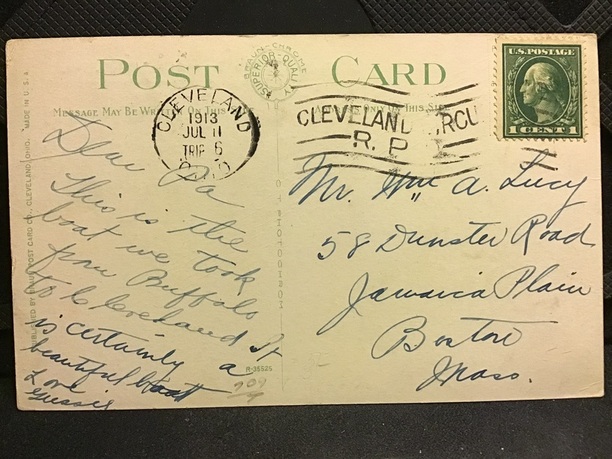
1913 postcard from Cleveland, Ohio, to Jamaica Plain, Massachusetts
In July 1913 Mr William A Lucy of Jamaica Plain, Massachusetts, received a postcard that his daughter sent from Cleveland, Ohio. The message read:
Dear Pa
This is the boat we took from Buffalo to Cleveland. It is certainly a beautiful boat.
Love
Gussie
Can we find out a little bit more about Mr Lucy and his daughter?
The Lucys
William A Lucy was born July 27, 1847, in Bradford, Essex County, Massachusetts, the son of William and Adeline (Davis) Lucy. The town of Bradford does not exist any longer. The section of Bradford where William was born became Groveland in September 1850, and he is on the 1850 census of Groveland with his parents. Their page of the census is dated September 11, 1850, after the formation of Groveland. According to the family trees on ancestry.com and familysearch, both sides of William's family are of old New England stock. And to paraphrase Bullwinkle, 'if you can't trust online trees, who can you believe?'
William Lucy married Emelia C Hjort on February 11, 1879, at the Flint Street Methodist Church, Somerville, Massachusetts. The marriage record said that Emilia was born in Malmbeck, Sweden, and that her parents' names were Johanes and Magdalena C. The membership records of the Emanuel Lutheran Church in Roxbury, Massachusetts, inform us that Emelia was born December 3, 1851, in Malmbeck and left for America from Gutenberg on May 3, 1872. Her destination was Boston. Emelia's first son, George William, was baptized at that church in 1880.
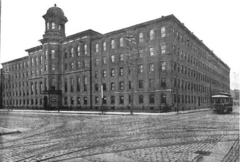
Chickering Factory, 1895
Besides George W, their family included Augusta, the daughter who sent the postcard. She was born March 27, 1883, in Boston. Their two other children were Annie Amelia (July 11, 1885, Boston) and Evangeline (May 20, 1889).
William Lucy worked as a cabinet maker for a piano factory most of his life. It was probably the Jonas Chickering Pianoforte Manufactory at 791 Tremont St, Roxbury, since William lived in that area before moving to Jamaica Plain. Addresses included Camden St, Greenwich St, and Columbus Ave. They settled in at 58 Dunster Road, Jamaica Plain, by 1912. William died January 30, 1922, and Emilia in 1943. They have no living descendants–Augusta's one son died childless, George W adopted his wife's three sons, Annie had no children, and Evangeline never married.
Augusta Wilhelmina Lucy
Augusta, as mentioned, was born March 27, 1883, at 73 Camden Street, in the South End. She married William Charles Stinson on December 2, 1907. From an article about her marriage we learn that she "studied for several years at the New England conservatory of music. She has a particularly fine voice, and has often appeared in concerts, being a member of the Handel and Hayden society." I tried to find out more about Augusta's singing career, but came up empty.
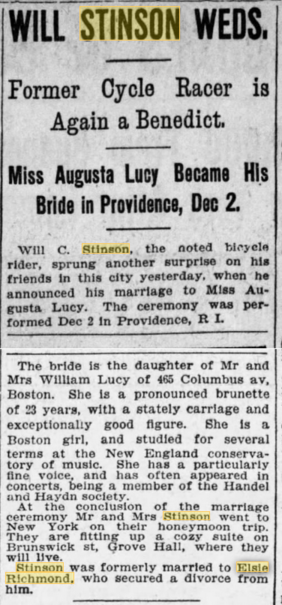
Boston Globe, December 21, 1907,
page 8
The article said the Stinsons' first home was on Brunswick St in Grove Hall, which is where they are listed in the 1908 Boston City Directory. They soon moved to 112 Talbot Avenue, then to 7 Blackwood Street in the South End by 1910, and finally to 58 Dunster Road in 1912 with Augusta's parents. The home was a duplex. Augusta was apparently still living on Dunster Road in 1954 when she died. She is in the 1954 Boston City Directory at that address.
Augusta (Lucy) and Will Stinson had one child, a son William Charles, born March 18, 1909, in Boston. He married Mary Elizabeth Powell and died in 1992 in Pinellas County, Florida.
William Charles Stinson
As you may have noticed from the newspaper clipping, Augusta's husband, Will Stinson, was a "bicycle rider." He was not a bicycle rider like you and I might be bicycle riders–he was a professional motor-paced (or slip-stream) cyclist around the turn of the 20th century. I had never heard of this sport but, after a lot of Googling, I think I can sum it up here:
A motor-paced cyclist raced behind a motorcycle ridden by one or two people. The cyclist would ride in the slipstream, or draft, of the motorcycle to minimize air resistance. Using this method, Will Stinson became the first man to bicycle forty miles in one hour, doing so at Brockton, Massachusetts, on October 25, 1900. According to the Courier Journal Almanac of 1901, found at Google Books, he also held at that time the American record for the 2, 30, 35, and 40 mile distances.
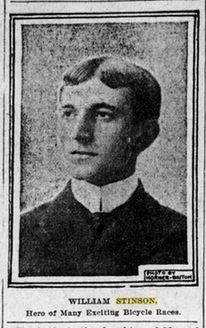
Will Stinson
To see the speed advantage of drafting behind a pacer when cycling, we can compare Will's times for 2, 30 and 40 miles with the record speed for unpaced cycling. The paced record for 2 miles was 2:51 2/5, unpaced was 4:25. For 30 miles, paced was 44:49, unpaced was 1:13:36. And for 40 miles Will's time was 59:43 versus the unpaced record of 1:59:56 3/5.
Motor-paced cyclists also raced against one another. The book Life in the Slipstream: The Legend of Bobby Walthour Sr., by Andrew M. Homan, (2011) states that the sport was dangerous. The author tells of the Memorial Day, May 30, 1903, 20 mile race at the Charles River track in Boston, in which prominent cyclist Harry Elkes was killed and Will Stinson was badly injured. After that, Will took a few years off from the racing circuit—the only other mention of him in the book is at a 1906 20 mile race in Revere.
Apparently Will Stinson discontinued racing by the time of his marriage to Augusta. Their marriage license lists him as a traveling salesman and his censuses from 1910 to 1940 all put him in sales, usually of books. Will Stinson died March 9, 1941, at his home in Jamaica Plain.
The "Sea and Bee"
Inquiring minds might be wondering what Augusta was talking about when she said on the card "This is the boat we took from Buffalo to Cleveland. It is certainly a beautiful boat."
The boat was the SS Seeandbee which made regular trips between Buffalo and Cleveland from 1913 to 1939. The postcard says it was the largest steamer on inland waters in the world at the time. Its parent company experienced financial losses in 1938 and the ship was sold to a company in Chicago. The Seeandbee sailed out of that city until 1941 when it was converted into a aircraft training vessel for use during World War II. It was scrapped after the war.
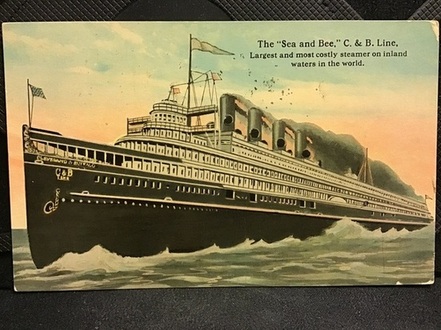
1913 postcard from Cleveland, Ohio, to Jamaica Plain, Massachusetts, front
For those interested, there is more on the Seeandbee at the Seeandbee at the Encyclopedia of Cleveland History and at See the Seeandbee, at cleveland.com. There is also a video at SS Seeandbee ~ The C&B Line Flagship at youtube.
The Postmark
You never know what you will learn when you pick up a postcard and start researching. The postmark on Augusta's card tells us that it was mailed on the Cleveland Circuit Railway Post Office route. The postal service operated a street rail car on the streetcar lines on the east side of Cleveland. It made nine trips a day, carrying mail to and from various substations before returning to the main post office. The card Augusta (Lucy) Stinson sent was cancelled on trip six for July 11, 1913.
I was a bit more interested in the Railway Post Office than in the SS Seaandbee. Vehicles are–to me anyway–just a way to get from one place to another. Stamps and postmarks are important 🙂. I found a very informative article about the Cleveland R.P.O. in this .pdf file at The Cleveland Circuit R.P.O., 1908-1919.
Sources
Other than the sources already mentioned, most of the information came from the US Censuses, Boston, Cambridge, and Providence (RI) City Directories, and the Massachusetts Vital Records. The only unusual sources were the records of the Emanuel Lutheran Church, Roxbury, and the Swedish Emigration and Swedish Passenger Lists at ancestry.com.
Credits
The picture of the Jonas Chickering Piano Manufactory can be found at Wikimedia Commons and is said to be in the public domain. The newspaper clippings were found, I think, for free at newspapers.com, and the postcard itself is mine.